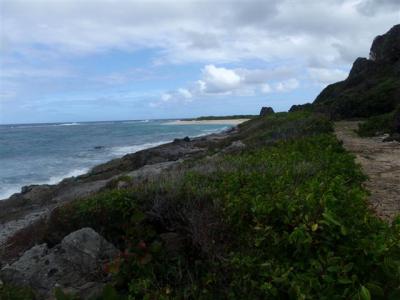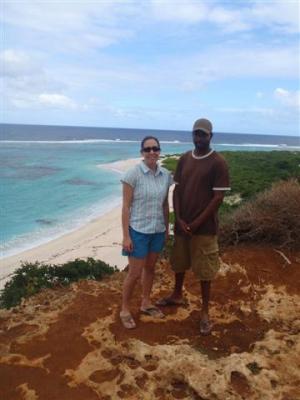Continued from yesterday”¦ After we were done eating, our new friends continued to roam the town while we went back to immigration. It was once again very simple. Just one form, and no fees. This agent was also causally dressed and professional, but curt. Our new friends rejoined us as soon as we were done, ice cream cones in hand. Christi thought Eric might die of jealousy.
The town is cute. It is very small, probably all of 6 or 7 blocks in total from what we can tell. Most of the buildings are low bungalows with metal roofs. Most look to be in good shape, with none appearing especially weather beaten. You definitely get a strong sense that everyone knows everyone else, and that they view themselves as a big family.
We took a dirt road east. It looked like mostly undeveloped land to us, though we did pass a few small farms. We also passed a few shacks in the middle of nowhere. They were kind off odd anomalies since pretty much everyone on the island lives in Codrington. The taxi driver explained that these are real Rastafarians, who choose to live a meager and quiet existence close to the earth and away from society. They grow their own food and er, uh, plants that they use in “religious rituals”. The taxi driver said that the government turns a blind eye to the plants as long as it is for personal use and not shared with others. Anyway, the undeveloped land contains mostly scrubby, desert kinds of plants. It is pretty dry overall — it is clear they don’t get much rain here.
We came to the middle of the east coast, to an area called “The Highlands”. It is a scenic spot overlooking the water. There is no beach, instead the coast is jagged rock. Behind us were the cliffs that make up the highest point of the island at about 125 feet above sea level. The cliffs simply rise sharply and dramatically out of nowhere. We parked at the end of the road, next to some ruins of an old building that was used in the 1890’s in conjunction with phosphate mining. The only reason it is still around is because it was built into a large rock. The taxi driver told us that pirates used to attack from here. They had a fake lighthouse, and as boats came in thinking it was a safe harbor, they would hit the reef and sink. Then the pirates would retrieve whatever booty was aboard. We read in a cruising guide that the Codringtons made an undisclosed amount of money bringing up treasure from some vessels that had sunk around the island.
The road turned into a foot path and we followed it a short ways to a fork. You could go left to a pretty beach or right to a cave. Here is the footpath. You can see how in the foreground the shore in jagged and in the background there is a beach. You can also see the cliffs rising up on the right.

We went to the cave. The cave has a large mouth, is quite tall, and not particularly deep. We were directed to the left wall, where you could follow a ledge up to a hole in the top of the cave. When we emerged through the hole, we were on top of the highlands hill. It is flat up there, has noticeably denser plant life (but the same plants) and has great views of the ocean below. You couldn’t really walk around much up there because the plants were too dense and there was no existing trail. Apparently quite a few wild animals live up there, but we didn’t see anything.

The town and the cool cave that leads up to the cliffs are really the main attractions on the island. The taxi driver took us back to town, we hopped in the taxi boat, and were dropped off back at the sand bar. The waves were a little bit bigger now than when we came in, but they were less consistent. Most of the waves were a couple feet, but now and again a bigger one would come in, and they were still sharp. We launched the dinghy into the water, jumped in, and had just started paddling away from the shore when Eric saw a huge wave about to break. It was the biggest wave he’d seen yet — a good 4 5 feet. The dinghy was just at the cusp of the break, and it was slightly angled. If we were literally a couple feet farther out, or even farther in, we would have missed the wave breaking on us. If we were perfectly straight into the wave, maybe, just maybe, we could have surfed it back into shore. Christi’s back was to the wave, so she didn’t know it was coming. She saw Eric’s eyes bug out of his head, and then suddenly we were underwater.
In the fray of being tossed over, Eric lost his eye glasses. Eric’s vision is poor and he really needs his glasses, so this was extremely bad. Christi quickly gathered the loose things floating in the water and took them to the beach while Eric held the dinghy and searched for his glasses. Once the loose things were on shore, Eric gave up on his eye glasses and we turned our attention to the dinghy. It was completely full of water, so shoving it up to shore was extremely difficult. The dinghy wanted to stay in the water and float out with the waves. We desperately tried to bail out the water to make it light enough to push up the sand, but as we bailed the water out, another wave would hit and fill it right back up. Eventually we got it far enough up the shore that we could tip it and drain the water out in between waves. Once the water was partially drained, we could get it even farther up the beach where it was out of the path of the waves.
We bailed the remaining water and mud, got our stuff together, took a few minutes to calm down, and launched again. This time we made it out with no problems. For those that don’t know, when you do a beach launch, you use your oars to get you out of the waves, then when you are far enough out, you turn on the engine. Of course, the dinghy engine was swamped and it would not start. Eric continued paddling. You may have noticed in the photo of the anchorage that the boats were pretty far away from where we were. We were the very farthest boat of all, at least a good solid nautical mile away, and maybe a little more. The wind was picking up. Fortunately, the wind was on our beam, but that still meant extra effort to keep us on track.
Christi decided to radio the other boats in the anchorage to see if someone would come and help us. We probably would have made it back just fine had we not asked, but it seemed silly not to ask for help with so many other boats around. Someone responded to our call right away, but it was one of the farthest boats away from us at the south end of the island. Fortunately, a nearby catamaran that must not have had his radio on signaled that he would help us. We called the guy who had volunteered back and thanked him, letting him know someone closer could help. Our new friend had his dinghy to us within two minutes and towed us in.
Eric put on his spare pair of glasses and we evaluated the damage. The dinghy is unharmed, and whether the engine will work when it dries out is an unknown. Most of the stuff in our backpack was in a dry bag, so we didn’t really lose anything beyond Kleenex and little things like that. We are not sure why, but we didn’t put our cruising guide in the dry bag with the wallet, cell phone, clearance paperwork and everything else of importance. We think we can salvage the cruising guide since the pages don’t seem to be sticking together. Most of the dinghy accoutrements, such as the life vest and anchor, were fastened down, so Christi was only chasing after things like our hats, backpack, shoes, etc. As far as we can recollect, we think we rescued everything but Eric’s glasses. Not too bad at all.
The next thing we did was check the weather. The other cruisers we had been with today had warned us that bad weather was coming in the next day or two. They were right. We had to move in the morning because the weather was coming from the north, and we were completely unprotected from the north side. Being in such shallow water, we would have breaking waves all around us.
We brought the dinghy up and secured it, knowing that it would be much easier to do today, while it was still relatively calm, than it would be tomorrow after the wind picked up. Eric washed the dinghy engine down.
We pored through our wet cruising guide, looking at various options. We had planned to spend another 3 or 4 more days in Barbuda, snorkeling our way around the island, then go to Antigua to meet Christi’s dad. We hate it when the weather decides it won’t cooperate with our plans. We really wanted to stay in Barbuda, but no anchorage looked suitably sheltered and easy to get to, with the best choice only protecting so-so given the conditions. And the weather only gets worse and worse, with 9 foot waves forecast for the day we had planned to go to Antigua. We didn’t particularly want to go to out in 9 foot seas, so it looked like we had no choice but to go to Antigua ASAP while weather allowed.
Once the plan was in place, Christi made dinner, we watched a movie, and went to bed early.

When will Eric get LASIK and resolve his eyesight problem, once and for all? Oh vey!
-rich
I agree Rich!!
Eric – I got ILASIK last year and it’s been an amazing difference. My vacations always had a sour note on them because I was always afraid of not being able to see if I lost my contacts while I was snorkling or if I lost my glass or broke them I would have been in BIG trouble. I had horrible eye sight with bad astigmatism. I also wasn’t able to have a good experience SCUBA diving my first time I tried because I was always so worried about when my mask would fill up with water and my contacts popping out. I never even made it down 10 feet. Sigh.
Anyway, it’s been a huge life changer for me since the LASIK. And, I got it down in San Diego with a great surgeon. Dre had the same surgeon. Let me know if you ever want the info!!
really enjoyed your first book and looking forward to getting the next. we live on a house boat and envy you your adventures, we did live out on the anchor for two years but unfortunatley due to health problems had move to a marina. we live at hope island resort marina on the gold coast
regards lynne and leon